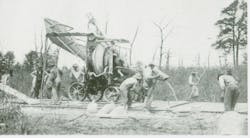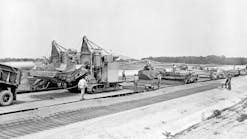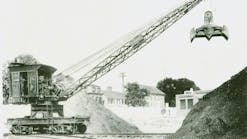Chester T. (1863-1918) and Charles E. (1858-1938) Foote were concrete contractors in Nunda, N.Y., with a knack for inventing things. Seeing the problems caused by boardwalks and dirt streets in inclement weather, they proposed building concrete sidewalks in Nunda. But mixing concrete by hand was an arduous process, so in 1896 they built their own mixer. Although not the first concrete mixer on the market, it was an improvement over existing designs, and it could produce about 4 cubic yards per hour using hand power.
The following year, they purchased a lot at the corner of State and Massachusetts streets in Nunda and built a 20x48-foot two-story workshop where they began to experiment with mixers and a Lambert gas engine for power. They perfected a gas-powered mixer in 1898, and used it to lay several thousand feet of concrete sidewalks in nearby Perry, N.Y., in 1900. They dubbed it the No. 1 Mixer and began advertising it in 1902 as the first “automatic (powered) proportioning mixer” in the United States
In 1903, the brothers founded the Foote Manufacturing Co. and built their first factory. They also developed the first mixer designed specifically for paving that year, the No. 3 Continuous Mixer. This machine differed from all other mixers in that the flow of material through the machine was parallel to its direction of travel. On all other portable mixers, the skip for receiving dry materials was on one side, and the drum was charged from that side and discharged concrete to the other. This created inefficiencies in moving the mixer as it laid a slab of pavement along a street.
On the No. 3 Continuous mixer, the arrangement was turned 90 degrees. Dry materials were received in front, and concrete was discharged from the rear, so as the slab was laid behind it, the mixer was simply pulled forward. The No. 3 Continuous Mixer was a success, and the factory was expanded almost at once. A self-propulsion system for the No. 3 Continuous Mixer was introduced in 1905, making it even more efficient.
The company’s greatest innovation came in 1918 when Charles E. Foote and chief engineer George E. Blood perfected the use of crawlers rather than steel wheels for propulsion of paving mixers. This greatly increased their flotation and eliminated the need for support timbers, while reducing damage to the subgrade. Dubbed the Multifoote and advertised as “The Paving Tank,” these pavers had a remarkably low ground pressure of 7 psi; sales literature depicted one working on a subgrade so soft a man had to cross it on a beam to keep from sinking in.
Foote was acquired by The Blaw-Knox Co. in 1948, and the former Foote line of dry batch pavers was heavily outsold by those of Koehring Co. through the 1950s.
Equipped with a swinging boom and traveling bucket on the discharge end for placing the concrete, the crawler-mounted dry batch paver became the standard machine for producing concrete pavement until modern central mix plant technology rendered them obsolete in the early 1960s. A few were even converted to mixers for these plants, but this reprieve was short-lived.
The Historical Construction Equipment Association (HCEA) is a 501(c)3 nonprofit organization dedicated to preserving the history of the construction, dredging and surface mining equipment industries. With more than 4,000 members in 25 countries, activities include operation of National Construction Equipment Museum and archives in Bowling Green, Ohio; publication of a quarterly magazine, Equipment Echoes, from which this text is adapted, and hosting an annual working exhibition of restored construction equipment. Individual memberships are $30 within the U.S. and Canada, and $40 elsewhere. Information is available at www.hcea.net, 419.352.5616, or [email protected].





